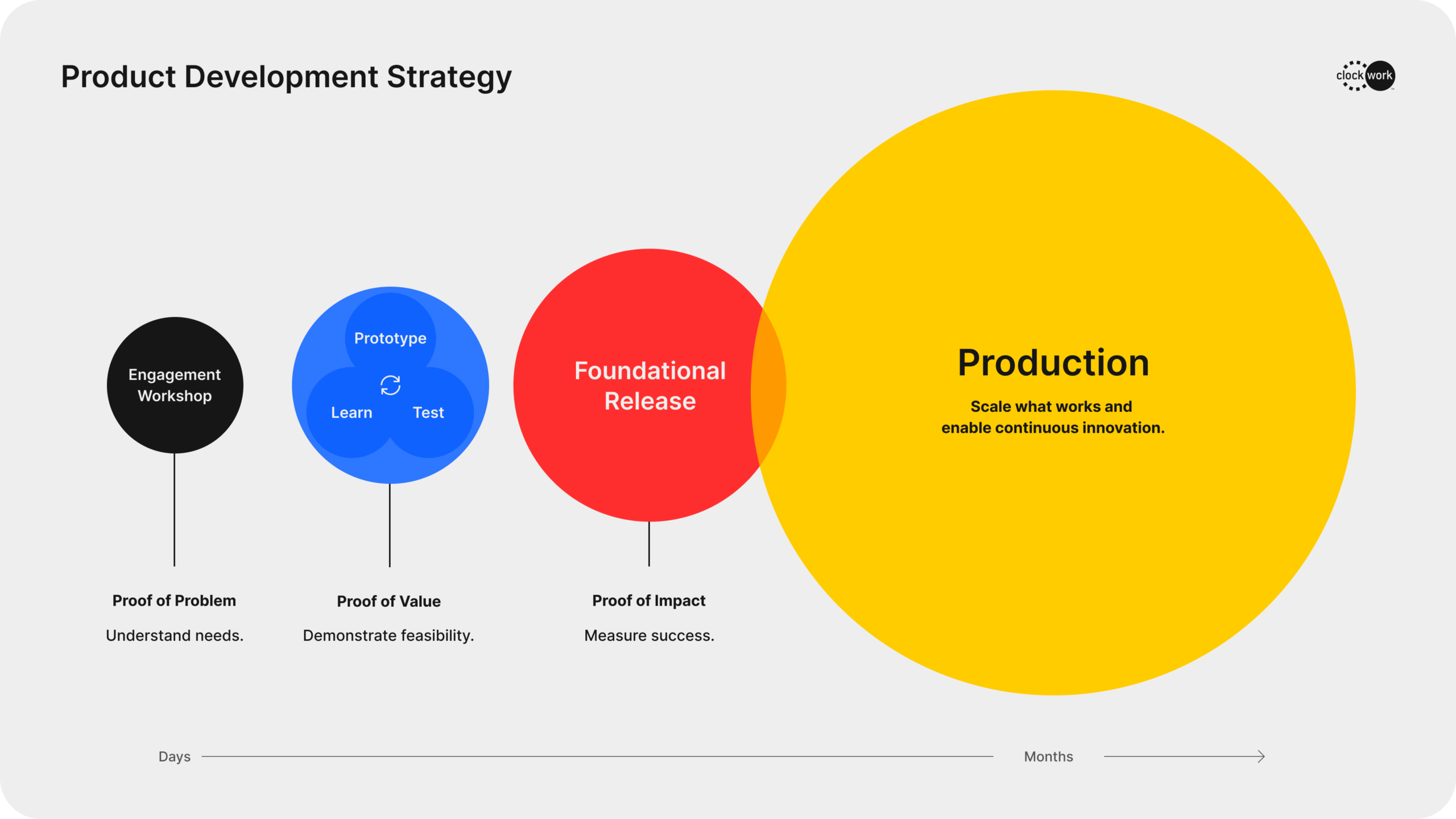In today’s digital landscape, design systems have emerged as essential tools for creating consistent, scalable experiences. But when should your organization invest in a design system? When might simpler approaches work better? And how is AI transforming these decisions? Let’s examine the strategic value of design systems and how to implement them effectively.
Understanding design systems
First, let’s establish a clear definition: A design system is more than just a collection of UI elements or a style guide. It’s a comprehensive ecosystem of standards, documentation, and reusable components that serves as a shared language for all members of the product team.
As design writer Nathan Curtis puts it: “A design system isn’t a project. It’s a product, serving products.”
This perspective matters. When we view a design system as a product with its own lifecycle, we recognize the need for ongoing investment, strategic planning, and evolutionary development. A successful design system grows and adapts alongside your business, providing increasing value over time.
When design systems create strategic value
Managing complex product ecosystems
When your organization manages multiple products, platforms, or touchpoints, maintaining consistency becomes exponentially more challenging. Different teams naturally develop divergent interpretations of brand guidelines and create redundant solutions to similar problems.
Organizations with established design systems often achieve higher customer satisfaction compared to those without such practices. This improvement stems from the consistent experience that design systems enable across all customer touchpoints.
A unified design system creates a single source of truth, ensuring that every interaction reflects your brand’s core principles, regardless of channel or device.
Scaling teams while maintaining alignment
As your organization grows, onboarding new team members efficiently becomes critical to maintaining momentum. Design systems serve as comprehensive knowledge repositories that accelerate this process significantly.
Consider Shopify’s experience. As they expanded from a small team to hundreds of designers and developers globally, their Polaris design system became instrumental in maintaining quality and consistency. New team members could contribute meaningfully within days rather than weeks because core decisions and patterns were already established and documented.
This benefit extends beyond just faster onboarding; it creates space for deeper innovation by removing the cognitive burden of routine decisions.
How design systems support accessibility by default
Accessibility isn’t merely a compliance checkbox; it’s a fundamental aspect of equitable digital experiences. For many organizations, however, achieving consistent accessibility standards remains challenging, especially across multiple products and platforms.
Design systems address this challenge by embedding accessibility requirements directly into reusable components and patterns. When a button component is built with proper keyboard navigation, appropriate color contrast, and correct ARIA attributes, every implementation of that button inherits these accessibility features automatically.
IBM’s Carbon Design System exemplifies this approach, with accessibility guidelines built into every element. This systematic approach has significantly reduced accessibility issues across their digital portfolio—an improvement that would be difficult to achieve through individual project efforts.
By making accessibility a default characteristic rather than an add-on feature, design systems help organizations meet both ethical obligations and compliance requirements more effectively.
Accelerating decision-making and delivery
When teams spend excessive time debating foundational elements like button styles, typography choices, or form layouts, they’re not focusing on solving unique business challenges or addressing customer needs.
Using established design systems can help achieve significantly faster product development cycles. This acceleration occurs because teams can focus their cognitive resources on solving novel problems rather than repeatedly addressing familiar patterns.
The result is not just faster development but often better outcomes. When foundational decisions are handled systematically, teams have more capacity for user research, testing, and refinement of the truly differentiating aspects of their products.
When simpler approaches may be appropriate
Despite their benefits, design systems require significant investment in creation, governance, and maintenance. Here are scenarios where alternative approaches might better serve your organization:
Limited digital scope and scale
Organizations with a small digital footprint, perhaps a single website or application with limited complexity, may find that a comprehensive design system introduces more overhead than value. The resources required to build and maintain a robust system could potentially be better directed toward other initiatives.
For these organizations, a more focused component library or lightweight style guide often provides many of the consistency benefits without the same level of investment. As digital needs expand, these foundational elements can evolve organically into a more comprehensive system.
Periods of rapid experimentation
Some business contexts, particularly in emerging technologies, startup environments, or highly competitive markets, require the freedom to experiment rapidly and pivot frequently. During these phases, the constraints of a formal design system might limit necessary exploration.
Organizations navigating these contexts should consider establishing lightweight design principles and a minimal shared component set while explicitly creating space for experimentation. This balanced approach maintains some consistency while enabling the rapid iteration required for breakthrough innovation.
Once patterns stabilize and successful approaches emerge, these experiments can inform a more comprehensive system.
Strategic approaches: Build, adopt, or blend?
A critical decision for many organizations is whether to build a custom design system, adopt an existing one, or take a hybrid approach. Each path offers distinct advantages and considerations.
Leveraging established systems
Platforms like Google’s Material Design, Microsoft’s Fluent Design System, and Apple’s Human Interface Guidelines represent massive investments in research, testing, and refinement.
Adopting these systems offers several compelling advantages:
- Implementation efficiency: These systems provide thoroughly tested components with production-ready code implementations, significantly reducing development time and technical debt.
- User familiarity: Consumers already understand these interaction patterns, reducing learning curves and minimizing friction, particularly for utility-focused applications.
- Accessibility compliance: Major systems incorporate extensive accessibility testing and compliance, helping organizations meet legal requirements with greater confidence.
- Continuous evolution: These systems are maintained by dedicated teams who constantly incorporate emerging best practices and technology advancements.
Research from UXPin indicates that teams leveraging established design systems achieve significantly faster time-to-market for new features compared to teams building everything from scratch.
Building custom systems
Despite the efficiency advantages of established systems, custom design systems remain essential for many organizations, particularly when:
- Your brand requires distinctive expression: If your competitive differentiation depends on a unique digital experience that sets you apart from competitors.
- Your industry has specialized interaction patterns: If your domain involves specialized workflows or information displays not adequately addressed by general-purpose systems.
- You need deeper integration with proprietary technology: When your digital ecosystem incorporates custom technologies or platforms requiring specialized components.
Custom systems allow precise alignment with your business objectives and user needs, though they require significantly more investment to build and maintain.
The strategic hybrid approach
Many leading organizations have found success with a thoughtfully blended approach. Companies like Airbnb developed their custom Design Language System (DLS) while still incorporating established patterns for standard interactions, focusing their innovation on areas central to their unique experience.
This “custom where it counts” strategy allows organizations to balance brand differentiation with implementation efficiency. By leveraging existing solutions for common patterns and investing deeply in custom components for differentiating experiences, teams can optimize both resources and outcomes.
Financial services company Capital One took this approach with their Gravity design system, incorporating principles from Material Design alongside other established systems and their own custom patterns to create a cohesive system that addresses their specific regulatory requirements and customer expectations.
Design systems and AI: A transformative convergence
The rapid evolution of artificial intelligence (AI) is fundamentally changing how design systems are created, implemented, and maintained. This technological shift brings exciting possibilities while introducing new considerations.
AI as a design system accelerator
AI tools like GitHub Copilot, Claude, and various code generation platforms are dramatically changing how design system components are created and implemented. Tasks that once required days of development time can now be generated and refined in hours.
Forward-thinking companies are pairing with AI tools to generate consistent interface components based on established brand guidelines, allowing faster creation and iteration of design system elements. These tools don’t replace human developers but instead augment their capabilities, handling routine implementation so teams can focus on strategic decisions.
The most promising applications combine human creativity with AI efficiency, using generative tools to quickly implement design patterns while maintaining human oversight for quality and coherence.
Bridging design and development
The traditional gap between design specifications and production code represents a significant friction point in implementing design systems.
GitHub reports that developers pairing with Copilot complete tasks up to 55% faster than those without such assistance. And the upcoming “Vision for Copilot” feature promises even more efficiency by directly analyzing design assets and generating corresponding code, potentially eliminating many of the translation errors that occur between design and development.
For design system implementation, this acceleration means faster deployment and iteration cycles, allowing organizations to evolve their systems more responsively while maintaining consistency across different platforms and frameworks.
Balancing automation and governance
While AI excels at generating variations quickly, ensuring consistent implementation across complex systems still requires thoughtful human oversight and governance. The challenge shifts from creating components to effectively defining parameters within which AI generation should operate.
We’re witnessing the emergence of “AI guardrails” or governance frameworks that establish boundaries for AI-generated content while maintaining brand integrity and experience consistency. These guardrails define not just visual parameters but also accessibility requirements, interaction patterns, and content guidelines.
Organizations successfully integrating AI into their design system practices are those that thoughtfully define these boundaries, allowing automated generation to flourish within established principles.
The future: Intelligent design systems
Perhaps the most transformative potential lies in self-evolving design systems. These are frameworks that use AI to identify patterns, inconsistencies, and opportunities across digital experiences and automatically suggest or implement improvements.
As these capabilities mature, we’re moving toward design systems that don’t just enforce consistency but actively improve experiences through ongoing learning and adaptation.
Charting your design system strategy
The optimal approach to design systems varies significantly based on your organization’s specific context, scale, and objectives. Here’s a framework for determining your path forward:
Enterprise organizations
If you’re managing multiple digital products across different platforms with distributed teams, a comprehensive design system investment will likely yield significant returns. Consider a strategic hybrid approach: adopt established patterns for standard interactions while developing custom components for unique, differentiating experiences.
Focus initially on your highest-impact touchpoints and most frequent interactions, then expand systematically based on measured outcomes. Establish clear governance structures and dedicated resources for ongoing maintenance and evolution.
Mid-market organizations
For mid-sized companies balancing growth with resource constraints, focus on developing a “minimum viable design system” that addresses your most critical needs while establishing foundations for future expansion.
Start with design tokens (foundational elements like colors, typography, and spacing), core components, and essential patterns. Document not just the what but the why behind design decisions. Demonstrate value incrementally before expanding scope, using metrics tied to business outcomes to validate your approach.
Emerging organizations
For startups and smaller organizations, begin with lightweight documentation and a focused component library addressing your most frequently used interface elements. Consider using established systems like Material Design or Tailwind as foundational frameworks, customizing only what’s necessary for your unique brand expression.
This approach provides immediate consistency benefits while conserving resources for other priorities. As your digital footprint grows, these foundations can organically evolve into more comprehensive systems.
Measuring success and demonstrating value
Regardless of your approach, establishing clear metrics and measurement frameworks is essential to evaluating your design system’s impact and guiding its evolution:
- Efficiency Metrics: Measure concrete time savings in design and development cycles. Track metrics like time-to-implementation for new features or reduction in design-to-development handoff issues.
- Consistency Improvements: Systematically audit your digital ecosystem to quantify reductions in visual and interaction inconsistencies across products.
- Accessibility Compliance: Monitor improvements in accessibility scores across your digital properties, tracking progress against WCAG (Web Content Accessibility Guidelines) standards.
- Team Experience: Regularly survey designers, developers, and product managers to assess how the design system affects their workflows, collaboration, and job satisfaction.
- Business Impact: Connect design system maturity to business outcomes like conversion rates, customer satisfaction scores, and support ticket reductions.
McKinsey’s research indicates that companies effectively measuring and optimizing their design systems achieve approximately 32% higher revenue growth compared to those that don’t establish such measurement practices.
The human element: Culture and adoption
Despite all technical considerations, design systems ultimately succeed or fail based on human factors and organizational culture. The most technically sophisticated system will provide limited value if people don’t embrace and use it consistently.
Successful design system implementations prioritize:
- Comprehensive documentation that explains not just implementation details but underlying principles and rationales
- Onboarding and training programs that build capability across teams
- Cross-functional collaboration that fosters shared ownership and continuous improvement
- Recognition programs that celebrate teams effectively leveraging the system
As Jina Anne, design systems expert and founder of Clarity Conference, notes: “Design systems are for people. They will only succeed if they truly serve the needs of the people using them.”
This human-centered perspective should guide every aspect of your design system strategy from initial conception through ongoing evolution.
Creating balance between systems and innovation
Design systems represent one of the most powerful approaches to scaling consistent, accessible digital experiences that align with both business objectives and user needs. Whether building your own, adopting an existing system, or pursuing a hybrid strategy, success depends on thoughtfully balancing systematic efficiency with space for creative exploration.
The organizations achieving the greatest impact are those that view their design systems not as rigid constraints but as enabling frameworks that accelerate implementation of proven patterns while creating space for focused innovation where it matters most.
At Clockwork, we partner with organizations of all sizes to develop design system strategies that achieve this crucial balance—creating the foundation for coherent digital ecosystems while enabling the distinctive experiences that drive competitive advantage.
Ready to explore how a strategic design system approach could transform your digital experience? Let’s talk!




